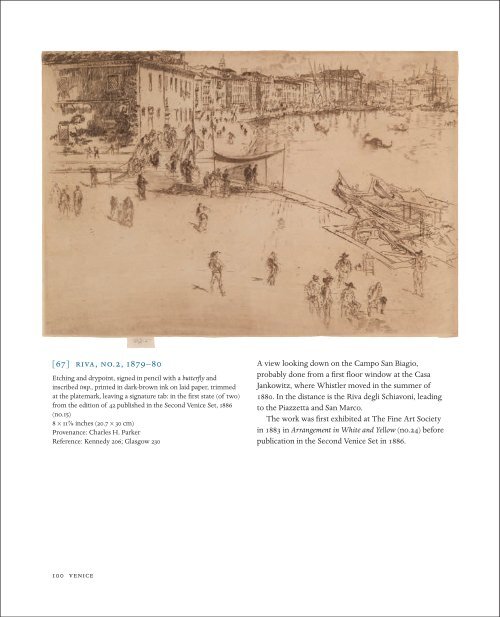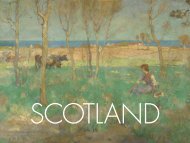You also want an ePaper? Increase the reach of your titles
YUMPU automatically turns print PDFs into web optimized ePapers that Google loves.
[67] Riva, No.2, 1879–80<br />
Etching and drypoint, signed in pencil with a butterfly and<br />
inscribed imp., printed in dark-brown ink on laid paper, trimmed<br />
at the platemark, leaving a signature tab: in the first state (of two)<br />
from the edition of 42 published in the Second Venice Set, 1886<br />
(no.15)<br />
8 x 11 7/8 inches (20.7 x 30 cm)<br />
Provenance: Charles H. Parker<br />
Reference: Kennedy 206; Glasgow 230<br />
A view looking down on the Campo San Biagio,<br />
probably done from a first floor window at the Casa<br />
Jankowitz, where Whistler moved in the summer of<br />
1880. In the distance is the Riva degli Schiavoni, leading<br />
to the Piazzetta and San Marco.<br />
The work was first exhibited at The Fine Art Society<br />
in 1883 in Arrangement in White and Yellow (no.24) before<br />
publication in the Second Venice Set in 1886.<br />
[68] San Biagio, 1880<br />
Etching and drypoint, signed in pencil with a butterfly and<br />
inscribed imp., printed in dark brown ink on tan laid paper,<br />
trimmed at the platemark, leaving a signature tab; in the sixteenth<br />
state (of seventeen), from the edition of 42 published in the<br />
Second Venice Set, 1886 (no.3)<br />
8 1/8 x 11 15/16 inches (20.8 x 30.3 cm)<br />
Provenance: Henry Harper Benedict (his stamp on the verso; Lugt<br />
1298)<br />
Reference: Kennedy 237; Glasgow 197<br />
When San Biagio was exhibited with the rest of the<br />
Second Venice Set at the Hogarth Club in 1887, an anonymous<br />
newspaper critic was prompted to observe that it<br />
“would be generally accounted to have the greatest variety<br />
of subject. It represents a quarter of Venice in which<br />
elegance battles bravely with squalor” (“Mr Whistler’s<br />
Etchings,” The Standard, March 3, 1887; quoted in<br />
Glasgow catalogue). He was presumably referring to the<br />
fact that the seventeenth-century warehouse depicted<br />
here, in front of the Calle and Corte de le Colone in<br />
the Campo San Biagio in the Cannaregio district, now<br />
housed impoverished workers; indeed, the inhabitants’<br />
laundry can be seen hanging from the windows and even<br />
right down over the archway. The artist was living in<br />
the Casa Jankowitz on the Riva San Biagio with several<br />
American art students in the summer or fall of 1880 and<br />
his room looked onto the Campo San Biagio.<br />
The composition was largely complete in the first<br />
state, which Whistler began in etching; in subsequent<br />
states he employed additional shading and lines in both<br />
etching and drypoint to further define the details and<br />
figures. San Biagio was first exhibited at The Fine Art<br />
Society in 1883 and the eighth state of the print was published<br />
as part of the Second Venice Set in 1886.<br />
100 VENICE james mcneill whistler: prints 101



